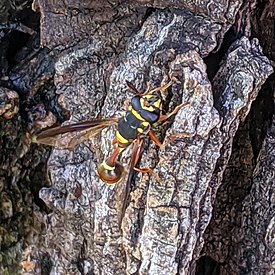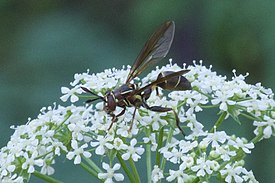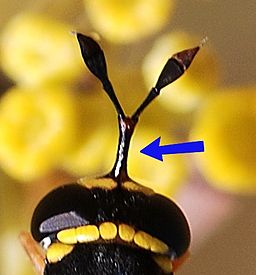Polybiomyia
Appearance
| Polybiomyia | |
|---|---|

| |
| Polybiomyia engelhardti missing antennae | |
| Scientific classification | |
| Kingdom: | |
| Phylum: | |
| Class: | |
| Order: | |
| Family: | |
| Subfamily: | |
| Tribe: | |
| Genus: | Polybiomyia Shannon, 1925
|
Polybiomyia is a genus of hoverfly.[1]
-
Polybiomyia bellardii
-
Polybiomyia lyncharribalzagai
-
Polybiomyia schnablei
-
Frontal prominence
-
antennae
Systematics
[edit]Species include:
- Polybiomyia ablepta (Riek, 1954) [2]
- Polybiomyia arietis (Loew, 1853)
- Polybiomyia bassleri (Curran, 1941) [3]
- Polybiomyia bellardii (Shannon, 1925)
- Polybiomyia bequaerti (Curran, 1938)
- Polybiomyia bolivari (Thompson & Wyatt, 2015)
- Polybiomyia divisa (Walker, 1857)
- Polybiomyia engelhardti (Shannon, 1925)
- Polybiomyia lyncharribalzagai (Shannon, 1927)
- Polybiomyia macquarti (Shannon, 1925)
- Polybiomyia nigra (Bigot, 1884)
- Polybiomyia odontomera (Curran, 1941) [3]
- Polybiomyia pedicellata (Williston, 1887)
- Polybiomyia plaumanni (Curran, 1941) [3]
- Polybiomyia rufibasis (Bigot, 1884)
- Polybiomyia sayi (Shannon, 1925)
- Polybiomyia schnablei (Williston, 1892)
- Polybiomyia schwarzi (Shannon, 1925)
- Polybiomyia signifera (Loew, 1853)
- Polybiomyia townsendi (Snow, 1895)
- Polybiomyia travassosi (Lane & Carrera, 1943)
| Genus | frontal prominence | abdominal segment 1 | abdominal segment two constriction | abdominal segment 2 length | paraface | other |
|---|---|---|---|---|---|---|
| Ceriana | as long as scape | same size as segment 2 | not constricted | wider than long | very short paraface | looping in third vein R4+5 with spur branch projecting into cell r4+5 |
| Monoceromyia | as long as scape | wider than segment 2 | strongly constricted | longer than wide | loop of vein R4+5 without Spur branch | |
| Polybiomyia | absent or very short | shorter than segment 2 | strongly constricted | longer than wide | vein R4+5 not looping | |
| Primocerioides | shorter than scape | not constricted | wider than long | long paraface and large anterior tentorial pit | eyes and face pilose, vein R4+5 straight | |
| Sphiximorpha | shorter than scape | wider than 2 | slightly constricted anteriomedially | longer than wide | long paraface and large or deep anterior tentorial pit. | Facial tubercle weak to nearly absent. vein R4+5 not looping. |
References
[edit]- ^ Ricarte, A., Marcos-garcía, M. A., Rotheray, G. E. & Hancock, E. G. (2007). The Early Stages and Breeding Sites of 10 Cerioidini Flies (Diptera: Syrphidae). Annals of the Entomological Society of America 100(6):914-924 doi:10.1603/0013-8746(2007)100[914:TESABS2.0.CO;2]
- ^ Riek, EF (1954). "The Australian syrphid flies of the subfamily cerioidinae (Diptera: Syrphidae): Systematics and wing folding". Australian Journal of Zoology. 2 (1): 100–130. doi:10.1071/ZO9540100.
- ^ a b c Curran, C.H (1941). "New American Syrphidae". Bulletin of the American Museum of Natural History. 78: 243–304.
- ^ Shannon, Raymond (1927). "Notes on and descriptions of Syrphid flies of the subfamily Cerioidinae". Journal of the Washington Academy of Sciences. 17: 38–53.
- ^ Brunetti, Enrico (1923). Diptera Vol. III. Pipunculidae, Syrphidae, Conopidae, Oestridae. London, England: Taylor and Francis. pp. 1–424.





